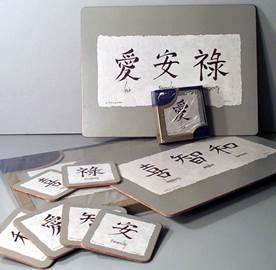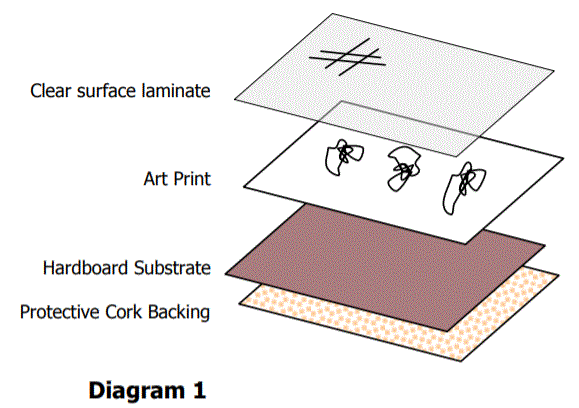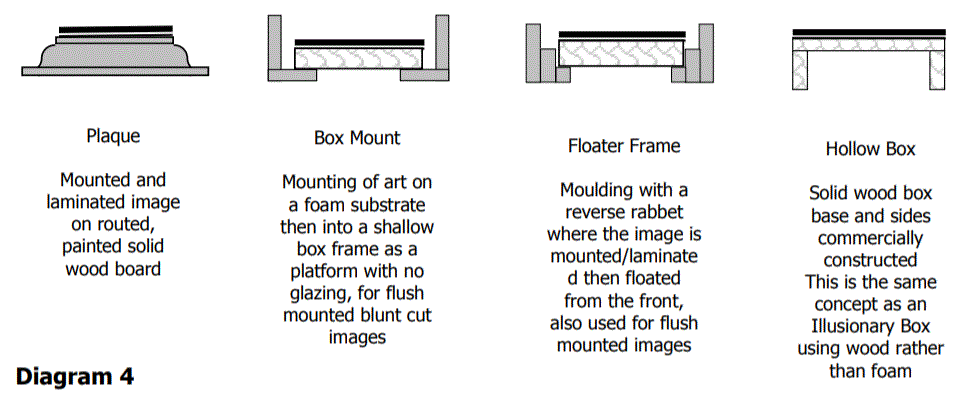Paschke Online
Designs Ink Publishing Article Archive and Reference Library
Articles by Chris A. Paschke, CPF GCF
Picture Framing Magazine
"Plaquing: Where it all Began"
Mat Design Issue, June 2001
Plaquing is not new. In fact, it's been in the framing industry for decades. And although it is a contemporary approach, it emulates classic 18th century decoupage. That is the art of applying cut paper images to furniture and accessories, then layering it with 30-35 coats of lacquer, sanding it smooth every five coats, and making it appear to have been hand painted. Thirty years ago decoupage was very popular in the craft market. By the end of the 70s, traditional decoupage layering techniques had evolved into the more expeditious method of mounting stripped posters (much like canvas transferring) to painted boards using acrylic mediums that cleaned up with water and dried quickly. Still known as decoupage but now much faster and user friendly.
 Photo 1
Photo 1
These placed placemats and coasters are samples of the original type of laminated materials produced by Richard Kelley in the early 1970s. These particular images of Chris Paschke's have been licensed to Pimpernel International, England by Wild Apple Licensing.
History Revisited
The current method of mounting and laminating a certificate, photograph or open edition reproduction (poster) onto wood has been around for a long time, but obviously not since the 18th century. The concept of plaquing was first introduced to the mass production and framing markets in North America, in the early 70s by Drytac Corporation, out of Canada.
It has been a huge industry in Canada and Europe ever since its introduction, but never really took off in the US. Then in Atlanta last September I noticed that HUNT Corporation has begun teaching plaquing using their tissues and laminates. Though it is commercially done with hydraulic heat presses in Canada, this technique has always been possible in mounting presses here in the States, but never really promoted until now.
Richard Kelley and the Birth of Plaquing
In 1963, Richard Kelley moved from London, England to Canada and started up a manufacturing company called Drytac Corporation, set upon serving the creative needs of the mounting and laminating customer. In 1971, he began importing and distributing giftware from UK which included mounted/laminated table placemats similar to those shown in photo 1.
This type of product had not previously been available in Canada, and became a huge success. He began to manufacture them himself with a machine he had located in England and almost immediately received an order for 24,000 coasters. Soon after he began to promote the idea of laminated pictures and photographs to framers and photographers and the business really took off. Plaquing was born into picture framing.
Off the Wall
Placemats and coasters such as these are still upper end home decor products that remain very popular today. I currently have a series of images published and licensed by Wild Apple Graphics that are currently in production by Pimpernel International out of England.
A closer examination of them illustrates the layered construction of a protective laminate applied to the surface, designed to withstand temperatures of 230°F without damage or separation. The art print is heat and pressure mounted to a substrate of hardboard made of eucalyptus wood backed with cork (diagram 1). These are often made in very high pressure hydraulic mounting presses, generally not found in the United States.
Besides the commercially produced placemats, framers can offer custom made placemats, as well as coasters, and serving trays. Old maps, lightfast wrapping papers, decorative papers, fabrics, perhaps even wallpaper could be used if thin enough and free of copyright. Photographs may be used as long as the customer has taken the photo whether traditionally or digitally, and owns the negative. Copyright free open edition prints may also be used. With a little imagination the possibilities are nearly endless.
Licensing and Copyright
That said, we must always remember the copyright issue when creating new products from images published with the intent of belonging in a picture frame. Preserving the dignity of the art by enhancing and protecting it is our job, even when we are working with open edition decorative art. Images offered in an array of assorted commercial products from placemats to drinking glasses to shower curtains to key chains have all been approved by the artist and they in turn are paid for that permission.
When we take an image and place it inadvertently onto a placemat or turn it into a serving tray we are breaking the artist copyright if we have not received permission to do so from their publisher. This is exactly the same issue I have discussed previously when teaching how to canvas transfer an open edition image. This falls into the same category. And as both a Wild Apple artist and licensee I understand this issue quite well.
Prior to turning any image into a plaque you should obtain publisher permission. The artist and publisher have the right to decide if they wish their printed art ought to be placed on a painted wood plaque, placemat, coaster or tray. As an artist I have been called numerous times by my publisher to obtain my permission to place my small Asian images onto plates as decaled transfers. Just as a watercolor image does not belong on a canvas transfer, my rice paper images worked on ceramic plates, but I would not approve of them on wood grain. It's sometimes a simple matter of media and not technique that could matter.
A Process by any Other Name
The process of plaquing has numerous names depending upon the company promoting the concept. It originated and I first heard about it in the late 80s when in Toronto when I first met Mr. Kelley. HUNT Corporation calls it plaque art, and I have seen it advertised commercially in art stores and trophy shops as plaque lamination as done by M.E.S. Lamination. And I'm certain there must be other names for it too.
Whether known as plaquing, plaque art, or plaque lamination; the concept, process, technique, equipment and most materials used remain basically the same. Designs are modified by the edging and presentation. Let's examine.
Plain, Float or Flat Mounting
Plain mounts (aka float mounts in the photo industry) are the most basic forms of print presentation and protection. When a print or photograph is premounted with a permanent adhesive, trimmed to remove outer adhesive to size, then mounted centered onto a colored backing board, it is called a floated mount. Photographs are commonly float mounted as 11"x14" photo prints onto a 16"x20" display board. Borders are generally 2-3" around and though this is not the preferred method for glazing and framing, it is frequently used for photo storage (diagram 2).
This concept of float mounting also applies to plaquing. Float mounts are a lightweight safe presentation since there is no glazing making them safe for hanging around children. They travel well and may later have frames placed around them as simple mounted laminated images if desired. This is perfect for displaying photos, new product information, signage, and commercial announcements.
Flush Mounting
When a mounted image extends clear to the edge of the substrate and is not matted it is known as flush mounting. Originally popular in the 1950s, it has traditionally been used with photographs but may also be done with posters and cards. The process is achieved by either trimming excess white edges from the print prior to mounting or by mounting everything slightly larger, then trimming down after mounting.
The mounted print/board unit may be bevel, reverse bevel, or square cut at the exact photo edge to create increased dimension. If the mounted photo is to be floated within a shadow box design frame, the edges will remain undamaged. If mounting photos for storage, flush mounting defeats the purpose of protecting edges from damage by trimming the board to the image edge, allowing it vulnerable to dents and bending.
Materials
Plaques may be produced as boards or often appear to be boxes, but are often not boxes at all. They may be constructed to have the illusion of depth to appear to be more of a box in presentation. Poster art, open edition reproductions, and photographs may be mounted and laminated onto a hard board as a substrate and in turn be completed in a box-like form. Rigid board surfaces most often selected for this technique include ⅛" Tempered Masonite®; ½", ¾", or 1" pine boards; ⅜" to 1" MDF (Medium Density Fiberboard); and sanded plywood.
These wood substrates may be blunt cut, bevel cut, reverse bevel cut, or decoratively routed to help create the illusion of either floating the image or outlining it as when flush mounting. Soft wood, with its edges routed and shaped is generally painted or stained prior to mounting then laminated so the exterior edging becomes the pseudo frame. This is similar to decoupage techniques popular in the craft industry during the 70's and 80's.
Types of Edging
Though I am discussing plaquing here which utilizes wood rather than foam board products, I have touted the use of thicker 3/16" and more rigid foam products like MightyCore, SmoothMount and Gatorfoam in the past to create nonwood mounting presentations called Illusionary Boxes (see PFM, May 1993). The same effects of edging for plain, flat, float, or flush mounting may all be achieved using these boards. But they are not really plaques then, just mounted laminated images onto a mounting paper substrate.
Equiment
Recently Drytac Corporation began selling a dynamic new edger called the DES-1. It is a large scale production unit designed for the serious plaquer. It shapes (routes), finishes, and applies the color to the edges of plaques in preparation for surface mounting and lamination. It is capable of bonding high temperature foils between 300°F - 365°F for the ultimate in decorative application. It also boasts a continuous feed conveyor to move the plaque from the shaping station to the cleaning station.
Traditional Plaquing vs Boxes
Plaquing is noted as the mounting and laminating of images to flat decorative edged boards. There are other types of mouldings and frames that also create a different look for posters and photo prints that also should be mentioned. These are noted and compared in diagram 4 as the basic plaque, box frame, floater frame, and hollow box.
The plaque and hollow box both have the structure and appearance of a solid board or box with an image mounted to the surface. The box frame and floater frame are obviously images mounted to a separate substrate then affixed into the frame. Though the diagram notes these as foam board, solid wood plaquing may also be fitted into the design.
Where Does Plaquing Fit In?
The technique of plaquing has been within our industry, having its roots in the UK, for nearly half a century. It will no doubt continue in select markets, particularly the OEM (original equipment manufacturer) market that supply art to furniture and discount stores. As professional custom picture framers the idea is to glaze and place beautiful mouldings around gorgeous multiple mats for fine art presentations.
Although we may ask the question of the validity of this technique in custom framing, we also realize as we venture into the gift market of ceramics, textiles and perhaps jewelry that there is much more to a gallery and custom frame operation than merely picture framing. The real question here might be if offering plaquing as an option to framing will bring in additional revenue by targeting a currently untapped market, or will it water down the desire for wider mats, fillets, and glazing on images for home decor.
Perhaps it is no contest after all. This process is only suitable for copyright free open edition images, not fine art limited editions. If all the options are presented to the customer by beautiful wall samples showcasing the difference between all price points and options, the customer will select the presentation they like best and that best suits their individual needs.
Offering everything the customer may want, need, or never even considered will make you the very best source for them to consistently bring their treasures. Plaquing may not be for every framer to offer, but if never considered before now, just keep an open mind. A few years ago we all thought that canvas transferring would be a flash in the pan too.
NOTE: A special thank you is extended to the companies who helped with the historic information and current product information. Excerpts and information taken from THE MOUNTING AND LAMINATING HANDBOOK, and CREATIVE MOUNTING, WRAPPING, AND LAMINATING, both available from PFM PubCo. Additional information supplied by Drytac Corporation, Hot Press International, and Hunt Corporation.
END
Copyright © 2001 Chris A Paschke
For more articles on mounting basics look under the mounting section in Articles by Subject.
Additional information on all types of mounting is found in:
The Mounting and Laminating Handbook, Second Edition, 2002,
The Mounting And Laminating Handbook, Third Edition, 2008 and
Creative Mounting, Wrapping, And Laminating, 2000 will teach you everything you need to know about getting the most from your dry mount equipment and materials as an innovative frame designer.
All books are available from Designs Ink Publishing through this website.
Chris A Paschke, CPF GCF
Designs Ink
Designs Ink Publishing
785 Tucker Road, Suite G-183
Tehachapi, CA 93561
P 661-821-2188
chris@designsinkart.com
 Photo 1
Photo 1


